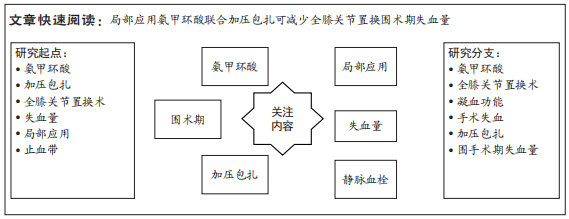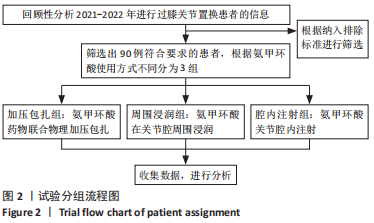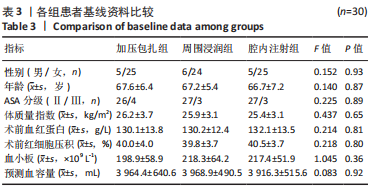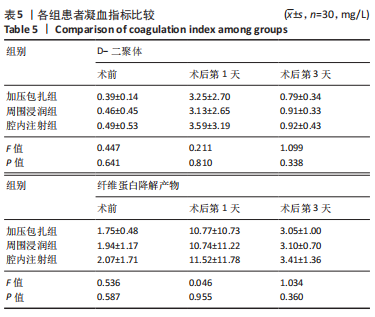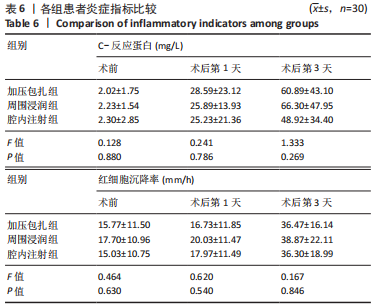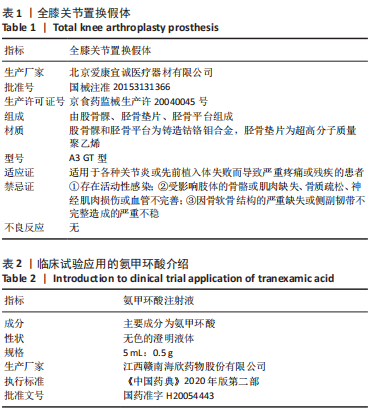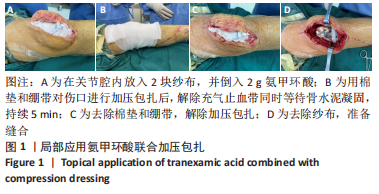[1] GIESINGER K, GIESINGER JM, HAMILTON DF, et al. Higher body mass index is associated with larger postoperative improvement in patient-reported outcomes following total knee arthroplasty. BMC Musculoskelet Disord. 2021;22(1):635.
[2] CHANG MJ, SHIN JY, YOON C, et al. Effect of Sequential Intravenous and Oral Tranexamic Acid on Hemoglobin Drop After Total Knee Arthroplasty: A Randomized Controlled Trial. J Bone Joint Surg Am. 2022;104(2):154-159.
[3] HUANG CR, PAN S, LI Z, et al. Tourniquet use in primary total knee arthroplasty is associated with a hypercoagulable status: a prospective thromboelastography trial. Int Orthop. 2021;45(12):3091-3100.
[4] LIN PC, HSU CH, CHEN WS, et al. Does tranexamic acid save blood in minimally invasive total knee arthroplasty?Clin Orthop Relat Res. 2011; 469(7):1995-2002.
[5] MISTRY JB, GWAM CU, NAZIRI Q, et al. Are Allogeneic Transfusions Decreasing in Total Knee Arthroplasty Patients? National Inpatient Sample 2009-2013. J Arthroplasty. 2018;33(6):1705-1712.
[6] CALLAGHAN JJ, SPITZER AI. Blood management and patient specific transfusion options in total joint replacement surgery. Iowa Orthop J. 2000; 20:36-45.
[7] STANWORTH SJ, COCKBURN HA, BORALESSA H, et al. Which groups of patients are transfused? A study of red cell usage in London and southeast England. Vox Sang. 2002;83(4):352-357.
[8] XUE CX, YAO YF, LV H, et al. Efficacy and Safety of Postoperative Intravenous Tranexamic Acid in Total Knee Arthroplasty: A Prospective Randomized Controlled Study. Orthop Surg. 2021;13(8):2227-2235.
[9] DELANEY M, WENDEL S, BERCOVITZ RS, et al. Transfusion reactions: prevention, diagnosis, and treatment. Lancet. 2016;388(10061):2825-2836.
[10] BENONI G, CARLSSON A, PETERSSON C, et al. Does tranexamic acid reduce blood loss in knee arthroplasty? Am J Knee Surg. 1995;8(3):88-92.
[11] HEYNS M, KNIGHT P, STEVE AK, et al. A Single Preoperative Dose of Tranexamic Acid Reduces Perioperative Blood Loss: A Meta-analysis. Ann Surg. 2021;273(1):75-81.
[12] RELKE N, CHORNENKI NLJ, SHOLZBERG M. Tranexamic acid evidence and controversies: An illustrated review. Res Pract Thromb Haemost. 2021; 5(5):e12546.
[13] ARTHUR JR, SPANGEHL MJ. Tourniquet Use in Total Knee Arthroplasty. J Knee Surg. 2019;32(8):719-729.
[14] ZHANG W, LI N, CHEN S, et al. The effects of a tourniquet used in total knee arthroplasty: a meta-analysis. J Orthop Surg Res. 2014;9(1):13.
[15] JULES-ELYSEE KM, TSENG A, SCULCO TP, et al. Comparison of Topical and Intravenous Tranexamic Acid for Total Knee Replacement: A Randomized Double-Blinded Controlled Study of Effects on Tranexamic Acid Levels and Thrombogenic and Inflammatory Marker Levels. J Bone Joint Surg Am. 2019;101(23):2120-2128.
[16] REALE D, ANDRIOLO L, GURSOY S, et al. Complications of Tranexamic Acid in Orthopedic Lower Limb Surgery: A Meta-Analysis of Randomized Controlled Trials. Biomed Res Int. 2021;2021:6961540.
[17] 周宗科,黄泽宇,杨惠林,等.中国骨科手术加速康复围手术期氨甲环酸与抗凝血药应用的专家共识[J].中华骨与关节外科杂志,2019,12(2): 81-88.
[18] YOZAWA S, OGAWA H, MATSUMOTO K, et al. Periarticular Injection of Tranexamic Acid Reduces Blood Loss and the Necessity for Allogeneic Transfusion After Total Knee Arthroplasty Using Autologous Transfusion: A Retrospective Observational Study. J Arthroplasty. 2018;33(1):86-89.
[19] PINSORNSAK P, PHUNPHAKCHIT J, BOONTANAPIBUL K. Efficacy and Systemic Absorption of Peri-articular Versus Intra-articular Administration of Tranexamic Acid in Total Knee Arthroplasty: A Prospective Randomized Controlled Trial. Arthroplast Today. 2021;11:1-5.
[20] PENG HM, WANG W, LIN J, et al. Multimodal Peri-articular Injection with Tranexamic Acid can reduce postoperative blood loss versus Intravenous Tranexamic Acid in Total Knee Arthroplasty: A Randomized Controlled Trial. J Orthop Surg Res. 2021;16(1):546.
[21] BOFFARD KD, CHOONG PI, KLUGER Y, et al. The treatment of bleeding is to stop the bleeding! Treatment of trauma-related hemorrhage. Transfusion. 2009;49 Suppl 5:240S-247S.
[22] LI GH, DING LM, SUN L, et al. Tranexamic Acid Combined with Compression Bandage Following Total Knee Arthroplasty Promotes Blood Coagulation: A Retrospective Analysis. Biomed Res Int. 2020;2020:2739560.
[23] AKKAN S, ÇORBACIOĞLU ŞK, AYTAR H, et al. Evaluating Effectiveness of Nasal Compression With Tranexamic Acid Compared With Simple Nasal Compression and Merocel Packing: A Randomized Controlled Trial. Ann Emerg Med. 2019;74(1):72-78.
[24] ENGELEN ET, SCHUTGENS RE, MAUSER-BUNSCHOTEN EP, et al. Antifibrinolytic therapy for preventing oral bleeding in people on anticoagulants undergoing minor oral surgery or dental extractions. Cochrane Database Syst Rev. 2018;7(7):CD012293.
[25] GROSS JB. Estimating allowable blood loss: corrected for dilution. Anesthesiology. 1983;58(3):277-280.
[26] NADLER SB, HIDALGO JH, BLOCH T. Prediction of blood volume in normal human adults. Surgery. 1962;51(2):224-232.
[27] MAHMOUDIAN A, LOHMANDER LS, MOBASHERI A, et al. Early-stage symptomatic osteoarthritis of the knee - time for action. Nat Rev Rheumatol. 2021;17(10):621-632.
[28] ZHENG C, MA J, XU J, et al. The Optimal Dose, Efficacy and Safety of Tranexamic Acid and Epsilon-Aminocaproic Acid to Reduce Bleeding in TKA: A Systematic Review and Bayesian Network Meta-analysis. Orthop Surg. 2023;15(4):930-946.
[29] HINES JT, PETIS SM, AMUNDSON AW, et al. Intravenous Tranexamic Acid Safely and Effectively Reduces Transfusion Rates in Revision Total Knee Arthroplasties. J Bone Joint Surg Am. 2020;102(5):381-387.
[30] WILDE JM, COPP SN, EZZET KA, et al. No Difference in Blood Loss and Risk of Transfusion Between Patients Treated with One or Two Doses of Intravenous Tranexamic Acid After Simultaneous Bilateral TKA. Clin Orthop Relat Res. 2022;480(4):702-711.
[31] XIE J, MA J, KANG P, et al. Does tranexamic acid alter the risk of thromboembolism following primary total knee arthroplasty with sequential earlier anticoagulation? A large, single center, prospective cohort study of consecutive cases. Thromb Res. 2015;136(2):234-238.
[32] LING T, ZHANG L, HUANG L. The efficacy and safety of combined administration of intravenous and intra-articular tranexamic acid in total knee arthroplasty: An update meta-analysis. J Clin Pharm Ther. 2022;47(9):1312-1321.
[33] MANNUCCI PM. Hemostatic drugs. N Engl J Med. 1998;339(4):245-253.
[34] JOO YB, KIM YM, AN BK, et al. Topical Tranexamic Acid Can Be Used Safely Even in High Risk Patients: Deep Vein Thrombosis Examination Using Routine Ultrasonography of 510 Patients. Medicina (Kaunas). 2022;58(12):1750.
[35] ABDALLAH AA, SALLAM AA, ARAFA MS, et al. Topical Tranexamic Acid in Total Knee Arthroplasty: Does It Augment the Effect of the Intravenous Administration in Patients with Moderate-to-High Risk of Bleeding? A Randomized Clinical Trial. J Knee Surg. 2021;34(14):1570-1578.
[36] LIU Y, MENG F, YANG G, et al. Comparison of intra-articular versus intravenous application of tranexamic acid in total knee arthroplasty: a meta-analysis of randomized controlled trials. Arch Med Sci. 2017;13(3):533-540.
[37] GONZÁLEZ OSUNA A, ROJAS LF, LAMAS C, et al. Population Pharmacokinetics of Intra-articular and Intravenous Administration of Tranexamic Acid in Patients Undergoing Total Knee Replacement. Clin Pharmacokinet. 2022; 61(1):83-95.
[38] SARZAEEM MM, RAZI M, KAZEMIAN G, et al. Comparing efficacy of three methods of tranexamic acid administration in reducing hemoglobin drop following total knee arthroplasty. J Arthroplasty. 2014;29(8):1521-1524.
[39] LEI YT, XIE JW, HUANG Q, et al. Benefits of early ambulation within 24 h after total knee arthroplasty: a multicenter retrospective cohort study in China. Mil Med Res. 2021;8(1):17.
[40] WAINWRIGHT TW, GILL M, MCDONALD DA, et al. Consensus statement for perioperative care in total hip replacement and total knee replacement surgery: Enhanced Recovery After Surgery (ERAS®) Society recommendations. Acta Orthop. 2020;91(1):3-19.
[41] SEHAT KR, EVANS R, NEWMAN JH. How much blood is really lost in total knee arthroplasty? Correct blood loss management should take hidden loss into account. Knee. 2000;7(3):151-155.
[42] TURAN S, BINGÖL O. Is tranexamic acid effective on hidden blood loss in patients during total knee arthroplasty? Jt Dis Relat Surg. 2020;31(3):488-493.
[43] 戴繁林,熊敏,张鹏,等.全膝关节置换术中氨甲环酸局部不同给药方式控制术后出血的效果评价[J].骨科,2015,6(6):298-301.
[44] LIN HY, LIN CY, HUANG YC, et al. Deep vein thrombosis after major orthopedic surgery in Taiwan: A prospective cross-sectional study and literature review. J Formos Med Assoc. 2022;121(8):1541-1549.
[45] LING T, ZHAO Z, XU W, et al. Effects of Tranexamic Acid on Hemorrhage Control and Deep Venous Thrombosis Rate After Total Knee Arthroplasty: A Systematic Review and Network Meta-Analysis of Randomized Controlled Trials. Front Pharmacol. 2021;12:639694.
[46] LOSTAK J, GALLO J, SLAVIK L, et al. Monitoring of fibrinolytic system activity with plasminogen, D-dimers and FDP in primary total knee arthroplasty (TKA) after topical, intravenous or combined administration of tranexamic acid. Biomed Pap Med Fac Univ Palacky Olomouc Czech Repub. 2020;164(2):168-176.
[47] WANG Y, XIE J, PEI F. Plasma D-dimer and FDP are promising biomarkers to predict perioperative fibrinolysis and bleeding following primary total joint arthroplasty: A STROBE compliant article. Medicine (Baltimore). 2021;100(20):e26058.
[48] ZHANG S, XU H, XIE J, et al. Tranexamic acid attenuates inflammatory effect and modulates immune response in primary total knee arthroplasty: a randomized, placebo-controlled, pilot trial. Inflammopharmacology. 2020;28(4):839-849.
[49] GRANT AL, LETSON HL, MORRIS JL, et al. Tranexamic acid is associated with selective increase in inflammatory markers following total knee arthroplasty (TKA): a pilot study. J Orthop Surg Res. 2018;13(1):149.
[50] LEI YT, XIE JW, HUANG Q, et al. The antifibrinolytic and anti-inflammatory effects of a high initial-dose tranexamic acid in total knee arthroplasty: a randomized controlled trial. Int Orthop. 2020;44(3):477-486.
[51] HASTINGS S, MYLES PS, MEDCALF RL. Plasmin, Immunity, and Surgical Site Infection. J Clin Med. 2021;10(10):2070.
[52] WANG J, ZHANG Z, LI J, et al. Tranexamic acid protects against implant-associated infection by reducing biofilm formation. Sci Rep. 2022;12(1):4840.
|
